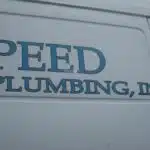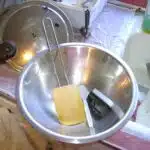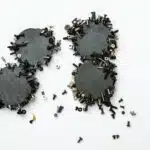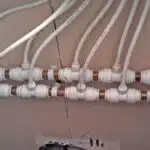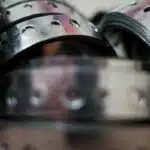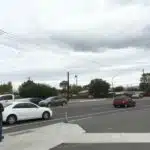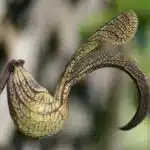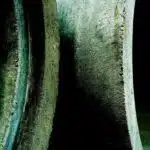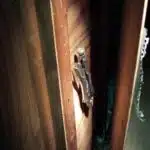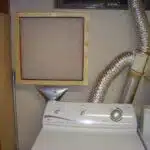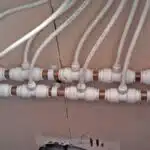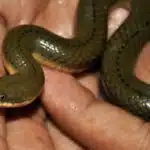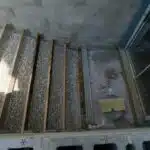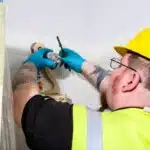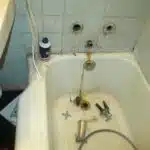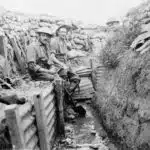As a plumbing installation expert, I have come across various plumbing systems that require different types of fittings. One of the most common fittings used in modern plumbing is the PVC saddle tee. This fitting is designed to connect a branch line into an existing PVC pipe without causing any damage to the mainline. Installing a PVC saddle tee requires a bit of skill and knowledge, but with the right tools and techniques, it can be done easily and efficiently.
In this article, I will guide you on how to install a PVC saddle tee step-by-step. Whether you are a DIY enthusiast or a professional plumber looking to expand your knowledge base, this article will provide you with all the necessary information on how to install a PVC saddle tee correctly. You will learn about the required tools and materials, safety precautions to take before starting the installation process, as well as techniques for joining pipes and fittings together. By following these guidelines, you can ensure that your plumbing system is properly installed and functioning efficiently for years to come.
Understanding Pvc Fittings And Their Uses
PVC fittings are essential components in plumbing installations, offering a reliable and durable solution for connecting different types of pipes. These fittings are made from polyvinyl chloride (PVC) material, which is renowned for its strength, versatility, and resistance to chemicals, corrosion, and temperature changes. PVC fittings come in various sizes, shapes, and designs to suit different applications, making them a popular choice among plumbers.
One of the benefits of using PVC fittings is their compatibility with various piping materials such as copper, steel, iron, and other plastic pipes. This feature enables plumbers to mix and match different pipe materials without worrying about leaks or joint failures. Additionally, PVC fittings can withstand high pressure and flow rates without compromising their structural integrity or performance. This makes them ideal for use in both residential and commercial plumbing systems.
Moreover, PVC fittings offer numerous advantages over traditional metal fittings such as ease of installation, cost-effectiveness, and low maintenance requirements. Unlike metal fittings that require special tools or welding equipment to join pipes together, PVC fittings can be easily connected using solvent cement or threaded connections. This not only saves time but also reduces labor costs associated with plumbing installations. Overall, PVC fittings provide a reliable and efficient solution for joining pipes while ensuring optimal performance and longevity.
When it comes to installing a PVC saddle tee on your plumbing system, it’s essential to identify the right type of fitting that suits your needs. Understanding the key features such as size, shape, material grade, and application requirements can help you choose the right product for your project. In the next section of this guide on how to install a PVC saddle tee fitting, we’ll explore some tips on how to select the best fitting for your plumbing installation needs.
Identifying The Right Type Of Pvc Saddle Tee
Understanding PVC fittings and their uses is important when it comes to installing a PVC saddle tee. This type of fitting is commonly used in plumbing systems to allow for the addition of a branch line without having to cut into the main line. There are different types of PVC saddle tees available, each designed for specific applications.
Before installing a PVC saddle tee, it is important to identify the right type and size for your plumbing system. The size of the fitting will depend on the diameter of the main line and the branch line that you want to add. Different types of saddles are available, including snap-on, glue-on, and threaded saddles. Each type has its own advantages depending on the application.
Once you have identified the right type and size of PVC saddle tee for your plumbing system, gather all necessary tools and materials before beginning installation. This may include a hacksaw or pipe cutter for cutting pipes, sandpaper or a deburring tool for smoothing rough edges, primer and solvent cement for bonding PVC fittings together, and a measuring tape or ruler to ensure accurate cuts. With proper identification and preparation, installing a PVC saddle tee can be straightforward and effective in expanding your plumbing system efficiently.
Gathering The Necessary Tools And Materials
A wise man once said, “a job done well is a job started with the right tools.” This statement holds true for installing a PVC saddle tee. Before beginning any installation project, it is essential to gather all the necessary tools and materials. Choosing the appropriate materials for this type of installation is vital to ensure its success. PVC pipes come in various sizes, and it is crucial to choose the right size for the saddle tee. Furthermore, make sure that all fittings are compatible with PVC pipes.
Budgeting for installation costs is another critical factor to consider before starting. The cost of installing a PVC saddle tee may vary based on various factors such as local labor rates, market prices for materials, and complexity of the installation process. Make sure that you have allocated enough funds to cover these expenses so that there are no delays or interruptions during the installation process.
As a plumbing installation expert, I always advise homeowners to do their research before starting any project. There are numerous online resources available that provide detailed instructions on how to install a PVC saddle tee. These guides also include lists of required tools and materials, which can help you prepare beforehand. By taking these necessary precautions, you can prevent potential problems from arising during installation.
Before starting your PVC saddle tee installation project, it is essential to ensure safety measures are in place. This includes turning off water sources and electricity if necessary. It’s crucial to wear protective gear such as gloves and goggles when working with PVC pipes or fittings as they can be sharp or cause irritation when handling them without proper protection. In addition, make sure that all tools are in good working condition to avoid accidents during installation. Remember always to prioritize safety above everything else when working on any plumbing project!
Ensuring Safety Measures Before Starting Installation
Prior to installing a PVC saddle tee, it is crucial to take the necessary safety measures. Plumbing installations can pose potential hazards, so it is essential to use the appropriate safety equipment before starting any installation work. Make sure to wear gloves and goggles to protect your hands and eyes from sharp objects and flying debris.
Before proceeding with the installation, conduct a pre-installation inspection of the area where you will be working. Check for any electrical wires or gas pipes that may be in close proximity to your work area. This is particularly important if you are working in a basement or crawl space where these lines may not be readily visible. It is also essential to check for any water leaks or moisture build-up in the area.
To ensure a safe and successful installation, consider the following list of safety precautions:
- Always turn off the water supply before beginning any plumbing work.
- Keep all tools and materials organized and within reach.
- Follow safety guidelines provided by manufacturers when using power tools.
With these safety measures in place, you can proceed with confidence knowing that you have taken all necessary precautions to safeguard yourself and anyone else who may be present during the installation process. In the next section, we will discuss how to measure and mark the pipe for installation without causing damage or compromising its structural integrity.
Measuring And Marking The Pipe For Installation
Ensuring safety measures before starting any plumbing installation is crucial. Once you have taken all the necessary precautions, it’s time to move onto the next step in installing a PVC saddle tee – measuring and marking the pipe for installation. The accuracy of your measurements is paramount as even a slight miscalculation can lead to costly mistakes.
When measuring the pipe for installation, use reliable tools to ensure accuracy. A tape measure or a ruler can work well for most projects. However, for larger pipes, it’s best to use calipers or other specialized measurement tools. Before marking the pipe, make sure that it is free of any debris or dirt that may affect the accuracy of your measurements.
Marking techniques vary depending on personal preference and project requirements. Some people prefer using a permanent marker while others opt for chalk or pencil markings. Regardless of which marking tool you use, make sure that it is visible and does not fade easily. Double-check your measurements before making any markings on the pipe to avoid errors.
Moving onto cutting the pipe to size, be sure to follow proper procedures to avoid damaging both the pipe and yourself. With accurate measurements and markings in place, you can now proceed with confidence in cutting the pipe down to size without fear of making costly mistakes. Cutting too much or too little can lead to issues later on in the installation process, so take your time and double-check everything before making any cuts.
Cutting The Pipe To Size
Measuring the pipe accurately is crucial to ensure a proper fit when installing a PVC saddle tee. There are various measuring techniques that can be used, such as using a tape measure or a pipe cutter’s gauge. A tape measure is an inexpensive tool that accurately measures the length of the pipe. On the other hand, a pipe cutter’s gauge measures both the length and diameter of the pipe.
Once you have measured the required length of your PVC pipe, it is time to cut it to size. Cutting tools such as hacksaws or reciprocating saws can be used to cut through PVC pipes quickly and efficiently. Hacksaws are perfect for cutting small sections of PVC pipes, while reciprocating saws are suitable for larger diameter pipes or thicker walls.
To ensure accuracy and precision when cutting, use a straight edge to guide your cutting tool along with the marked line on your PVC pipe. This will help you avoid crooked cuts and ensure that your PVC saddle tee fits perfectly onto the pipe.
- Remember:
- Accurate measurements are key to ensuring a proper fit.
- This prevents leaks and potential damage.
- Use proper cutting tools such as hacksaws or reciprocating saws.
- This ensures efficient and precise cuts.
With the correct measuring techniques and cutting tools, you can easily cut your PVC pipe to size for installing your saddle tee. The next step is preparing the surface for installation by cleaning and sanding down any rough edges on both the saddle tee and PVC pipe surfaces.
Preparing The Surface For Installation
After cutting the PVC pipe to size, the next step in installing a PVC saddle tee is surface preparation. Before applying any primer or cement, it is essential to clean the surface thoroughly. The dirt and debris may prevent the primer and cement from bonding correctly, which can lead to leaks.
Surface preparation involves cleaning techniques such as sanding, wiping with a cloth, or using a wire brush. The goal of surface preparation is to create a clean and rough surface that will allow the primer and cement to adhere well. After cleaning the area around where you will install the PVC saddle tee, make sure there are no sharp edges on the pipe. Use sandpaper or a file to smooth out any rough spots before proceeding.
In conclusion, proper surface preparation is crucial for successful installation of a PVC saddle tee. Neglecting this step can result in leaks that can cause significant damage over time. By using appropriate cleaning techniques and ensuring no sharp edges remain on the pipe, you can create an ideal surface for applying PVC primer and cement in the subsequent section of this guide.
Applying Pvc Primer And Cement
Are you ready to take the next step in your plumbing installation journey? Congratulations! Applying PVC primer and cement is an essential process that requires careful attention to detail. It may seem like a simple task, but it can make or break your saddle tee installation. So, let’s dive into some tips and tricks to ensure a successful outcome.
Firstly, make sure to clean both the pipe and the saddle tee before applying any primer or cement. Any dust or debris can cause the glue to fail, resulting in a leaky joint. Secondly, apply the primer with a brush or applicator generously. The primer softens the plastic surface, allowing for better adhesion of the cement. Thirdly, apply the cement in an even layer around both surfaces without any gaps. A thick layer of cement may look good but can cause problems down the line.
Now that we have covered some tips and tricks let’s discuss common mistakes to avoid. Firstly, don’t rush through this process; give ample time for each coat of primer and cement to dry completely before moving onto the next step. Secondly, avoid over-priming or over-cementing as this can lead to weak joints or leaks. Thirdly, always use PVC-specific products; using other types of glue or primer can damage your pipes.
In summary, applying PVC primer and cement is a crucial step in installing a saddle tee successfully. Remember to clean your materials thoroughly before applying anything and follow our tips above to avoid common mistakes that could ruin your efforts! Now that you are all set with your primed pipe let’s move on towards attaching the saddle tee to it!
Attaching The Saddle Tee To The Pipe
After applying PVC primer and cement to the pipe, you are now ready to install the saddle tee. But before doing so, ensure that the pipe is properly prepared. This means that it should be free of any debris or dirt that could affect its connection with the saddle tee. Use a clean rag to wipe the pipe clean.
When positioning the branch line on the pipe, make sure that it is in a spot where it can easily connect with the saddle tee. It should be perpendicular to the pipe and at least three inches from any other fitting or joint. Once you have determined where to place it, mark it with a pencil or marker for easy reference.
Now that you have prepared the pipe and positioned the branch line, you can proceed with attaching the saddle tee to the pipe. In order to do this, follow your manufacturer’s instructions carefully. Typically, this involves placing primer and cement on both surfaces (the pipe and saddle tee) and then pressing them together firmly for several seconds. Make sure that they are properly aligned before joining them together.
Moving forward, joining the branch line to the saddle tee requires careful attention to detail in order for a secure fit. To avoid leaks or loss of pressure, take your time in following proper procedures for joining these two components together. With patience and care, installing a PVC saddle tee can be an easy task for those who are handy around plumbing installations.
Joining The Branch Line To The Saddle Tee
Although joining the branch line to the saddle tee may seem daunting at first, it is actually a straightforward process. One common concern that people have is whether or not they have properly positioned the branch line in relation to the saddle tee. To ensure proper positioning, it is important to carefully measure and mark where the branch line will meet the saddle tee before making any cuts.
Size considerations are also important when joining the branch line to the saddle tee. The size of the branch line should match that of the opening on the saddle tee, otherwise leaks and other issues can arise. It is important to select a saddle tee with an opening that matches both the size and material of your branch line.
Once you have properly positioned and sized your branch line, it’s time to secure the connection with hose clamps. This will require sliding a hose clamp onto both ends of the branch line before inserting it into the opening on the saddle tee. Once in place, tighten both hose clamps securely using a screwdriver until they cannot be tightened any further. With this step complete, you can move on to finishing your PVC saddle tee installation with confidence knowing that all connections have been made securely and correctly.
Securing The Connection With Hose Clamps
Once the PVC saddle tee is in place, it is essential to secure the connection using hose clamps. Hose clamps come in different types and sizes, which can be overwhelming for those who are new to plumbing installation. However, it is crucial to choose the right type of clamp as it affects the overall performance and safety of the installation.
Commonly used clamps include worm gear clamps, spring clamps, and ear clamps. Worm gear clamps are adjustable and can fit various sizes of hoses or pipes. Meanwhile, spring clamps have a lower profile but are easier to install than worm gear clamps. Ear clamps require a special crimping tool that secures the connection tightly.
When using hose clamps, there are common mistakes that people make that may lead to leaks or other problems in the future. One mistake is overtightening the clamp, which can cause damage to both the pipe and clamp and result in leaks. On the other hand, under-tightening can also cause leaks due to insufficient pressure on the joint. It is important to follow manufacturer instructions carefully when installing hose clamps.
Engage your audience with these nested bullet points:
- Choose the right type of clamp for your installation
- Worm gear clamps for adjustable fittings
- Spring clamps for ease of use
- Ear clamps for tight connections
- Avoid common mistakes when using hose clamps
- Overtightening or under-tightening
- Not following manufacturer instructions
- Using damaged or worn-out clamps
Now that you’ve secured your connection with hose clamps, it’s time to test for leaks and adjust as needed. A leaky connection can lead to water damage or other issues in your plumbing system. To test for leaks, turn on the water supply and observe if there are any drips or puddles forming around the connection area. If you detect a leak, turn off the water supply, and adjust the clamp according to manufacturer instructions. Once you’ve made the necessary adjustments, test again until there are no more leaks detected. Remember to check the connection periodically for any signs of wear or damage to ensure that it remains secure and leak-free.
Testing For Leaks And Adjusting As Needed
After securing the connection with hose clamps, the next step is to install a PVC saddle tee. This tee allows you to tap into an existing PVC pipe and add a new branch line without disrupting the flow of the main line. To install the saddle tee, follow these steps.
First, measure and mark the location where you want to install the saddle tee. Using a handsaw, cut out a section of the PVC pipe at this location. Clean and dry the area around the cut using sandpaper or a file. Then apply PVC primer and cement to both the pipe and the saddle tee according to manufacturer instructions. Place the saddle tee over the cut section of pipe and secure it in place using stainless steel screws.
Once you have installed your PVC saddle tee, it is important to test for leaks and adjust as needed. Adjusting techniques may include tightening fittings or adjusting valves to correct any leaks that are found during testing. Leak prevention strategies can also be implemented, such as using Teflon tape on threaded connections or applying sealant around gaskets.
| Column 1 | Column 2 |
|---|---|
| Proper installation | Avoid costly repairs |
| Regular maintenance | Ensure longevity |
| Professional advice | Save time |
| Quality materials | Increase efficiency |
Proper disposal of waste materials is an important aspect of any plumbing installation project. This includes disposing of excess cement or primer in accordance with local regulations. Always be sure to clean up any debris or waste materials from your work area once you have finished your installation. By following these guidelines, you can ensure that your plumbing installation is completed safely and effectively while minimizing any negative impact on your environment.
Proper Disposal Of Waste Materials
As responsible individuals, we must always be mindful of the impact our actions have on the environment. This includes the proper disposal of waste materials that come with plumbing installations such as PVC saddle tees. There are several disposal methods available, and each one has its own environmental impact.
One of the most common disposal methods is landfilling. Landfills are areas where waste materials are buried in the ground. While this method is convenient, it has a significant environmental impact. As waste decomposes, it releases methane gas and other harmful substances into the atmosphere. These can contribute to air pollution and climate change.
Another option for disposing of waste materials is recycling. Recycling involves collecting and processing materials to create new products. This reduces the need for new raw materials, conserves resources, and decreases the amount of waste sent to landfills. However, not all plastics can be recycled, so it’s important to check with your local recycling center which items they accept.
Lastly, composting is another eco-friendly disposal method that turns organic waste into nutrient-rich soil that can be used in gardening and farming. This method reduces greenhouse gas emissions by diverting organic waste from landfills where they would produce methane gas during decomposition.
When deciding on a disposal method for your PVC saddle tee installation waste materials, consider its environmental impact carefully. Remember that small changes in our daily actions can make a big difference in preserving our planet for future generations.
Transition:
Now that you know how to dispose of your PVC saddle tee installation waste properly let’s move on to maintaining your installation to ensure its longevity and efficiency without compromising its environmental impact.
Maintaining Your Pvc Saddle Tee Installation
- Cleaning of the PVC saddle tee should be done periodically to prevent any buildup of dirt or debris on the surface.
- Sealing of the PVC saddle tee should be done by applying a professional-grade PVC glue to the joints and connections.
- Inspecting the PVC saddle tee is necessary to make sure all connections are secure and free of leaks.
- Care should be taken during the cleaning process to avoid any damage to the PVC saddle tee.
- Before sealing, it is important to ensure that all surfaces are clean and free of debris.
- Regular inspections should be done to check for any potential signs of damage or deterioration.
Cleaning
When it comes to maintaining your PVC saddle tee installation, proper cleaning is an essential step. Cleaning methods vary depending on the type of material used for the tee, but most can be easily cleaned with soap and water. It’s important to avoid using harsh chemicals or abrasive materials that could damage the surface of the tee. Regular cleaning will help prevent buildup and keep your installation looking and performing like new.
One of the best maintenance tips for preserving your PVC saddle tee is to clean it regularly, especially after each use. This will not only help prevent buildup but also keep any potential clogs at bay. For more stubborn buildup, a gentle scrub with a soft-bristled brush can be effective. It’s also important to check for any leaks or cracks during cleaning, as addressing these issues early on can prevent more significant problems down the line.
Overall, proper cleaning and maintenance are crucial for ensuring the longevity and functionality of your PVC saddle tee installation. By following these simple steps, you can avoid costly repairs or replacements in the future while enjoying reliable performance from your plumbing system. Whether you’re a DIY enthusiast or rely on professional plumbers, taking care of your PVC saddle tee will pay off in the long run by keeping your system running smoothly without interruptions or headaches.
Sealing
Moving on to another important aspect of maintaining your PVC saddle tee installation, let’s talk about sealing. Proper sealing is essential for preventing leaks and ensuring the longevity of your plumbing system. One common mistake that many people make is not using the right type of sealant or not applying it correctly. This can lead to leaks and water damage, which can be costly and time-consuming to fix. In this section, we will discuss some tips for proper sealing to help you avoid these issues.
Firstly, it’s important to choose the right type of sealant for your PVC saddle tee installation. There are different types of sealants available, such as silicone-based or solvent-based sealants. Make sure to read the manufacturer’s instructions carefully before selecting a sealant that is compatible with your tee material and plumbing system. Additionally, you should use a high-quality sealant that is designed for plumbing applications to ensure a secure and long-lasting bond.
Once you have selected the appropriate sealant, it’s time to apply it correctly. One tip is to clean and dry the surface thoroughly before applying the sealant. Any debris or moisture on the surface can prevent the sealant from adhering properly and may compromise its effectiveness in preventing leaks. You should also apply a uniform amount of sealant around the entire circumference of your PVC saddle tee joint using a caulking gun or other suitable tool. Finally, make sure to allow sufficient curing time according to the manufacturer’s instructions before testing your installation for leaks.
In summary, proper sealing is crucial for maintaining your PVC saddle tee installation and preventing water damage caused by leaks. By selecting the appropriate type of sealant and applying it correctly, you can ensure a secure bond that will last for years to come. Avoid making common mistakes such as using an incompatible or low-quality sealant or failing to clean and dry surfaces properly before application. With these tips in mind, you can enjoy reliable performance from your plumbing system and avoid costly repairs down the line.
Inspecting
To ensure the longevity and optimal performance of your PVC saddle tee installation, regular inspection is crucial. As a plumbing installation expert, I highly recommend conducting inspections at least twice a year to detect any defects or issues before they turn into costly repairs. To help you with this task, I have compiled an inspection checklist that you can follow.
The first item on the inspection checklist is checking for leaks or water damage around the PVC saddle tee joint. Look for any signs of moisture, such as water stains or mold growth, which may indicate a leak in the system. Another important aspect to inspect is the condition of the tee itself. Check for cracks, chips, or other forms of physical damage that may compromise its structural integrity.
Aside from these common defects, it’s also essential to check if all fittings are secure and properly aligned with each other. Any misalignment or loose fittings can cause leaks or blockages within the system. By following this inspection checklist regularly, you can detect any issues early on and take appropriate action to prevent further damage to your PVC saddle tee installation.
Troubleshooting Common Issues With Pvc Saddle Tees
The installation of PVC saddle tees is a widely used plumbing technique that involves cutting a hole into an existing PVC pipe and fitting in a tee. While this process may seem straightforward, there are common issues that arise during installation. It is important to know how to troubleshoot these issues to ensure the successful completion of the project.
One common issue with PVC saddle tees is leakage. This can occur due to improper installation or a faulty product. To prevent leakage, it is essential to use high-quality PVC pipes and saddles, as well as ensuring that all connections are properly sealed with adhesive. If leakage does occur, it is recommended to remove the saddle and re-install it using proper techniques.
Another issue that can arise during installation is cracking or damage to the existing PVC pipe. This can be prevented by taking preventative measures such as thoroughly inspecting the pipe for any signs of weakness before installing the saddle tee. If damage does occur, it is important to replace the damaged portion of the pipe before continuing with installation.
In conclusion, while installing PVC saddle tees may seem like a simple task, there are common issues that can arise during installation which must be addressed promptly. By implementing preventative measures and utilizing common solutions for any issues that do arise, successful completion of the project can be achieved. As a plumbing expert, it is crucial to have a comprehensive understanding of these potential issues in order to provide quality service and ensure customer satisfaction.
Conclusion
In conclusion, understanding how to install a PVC saddle tee is essential for any DIY plumbing project. It is important to identify the right type of fitting and gather all necessary tools and materials before beginning the installation process. Safety precautions must always be taken to prevent injury during installation.
Measuring and marking the pipe accurately is crucial for a successful installation, as well as testing for leaks and adjusting as needed. Proper disposal of waste materials should also be considered to avoid environmental hazards. Maintaining your PVC saddle tee installation will ensure its longevity.
As a plumbing installation expert, I would advise troubleshooting any common issues with PVC saddle tees such as leaks or misaligned fittings. With careful planning and execution, installing a PVC saddle tee can be a simple and effective way to connect new piping without disrupting existing systems. Remember, “measure twice, cut once” – taking the time to measure accurately before cutting will save you time and money in the long run.
Image Credits
- “woman holding white textile standing beside body of water” by Les Anderson (featured)



